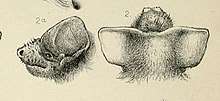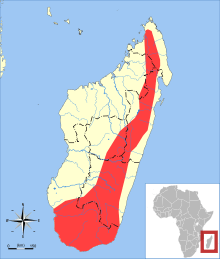Peters's wrinkle-lipped bat
Peters's wrinkle-lipped bat (Mormopterus jugularis), also called Peters's goblin bat, is a species of bat in the family Molossidae, the free-tailed bats. It is endemic to Madagascar, where it is widespread and in some areas abundant.[2] It commonly roosts in human-made structures, sometimes in colonies with other free-tailed bat species.[2][3] It forages in the open, often in agricultural areas.[2] The bat is sexually dimorphic, with males larger than females.[3]
| Peters's wrinkle-lipped bat | |
|---|---|
 | |
| Scientific classification | |
| Kingdom: | Animalia |
| Phylum: | Chordata |
| Class: | Mammalia |
| Order: | Chiroptera |
| Family: | Molossidae |
| Genus: | Mormopterus |
| Subgenus: | Mormopterus |
| Species: | M. jugularis |
| Binomial name | |
| Mormopterus jugularis Peters, 1865 | |
 | |
| Peters's wrinkle-lipped bat range | |
| Synonyms | |
| |
Taxonomy and etymology
It was described as a new species in 1865 by German naturalist Wilhelm Peters. Peters placed it in the now-defunct genus Nyctinomus and the subgenus Mormopterus, with the scientific name of Nyctinomus (Mormopterus) jugularis.[4] In his description of the species (in Latin), Peters wrote that it had "fovea jugulari magna", or a large suprasternal notch.[4] This anatomical feature was likely the inspiration for the species name "jugularis."
Description
From head to tail, it is approximately 90–95 mm (3.5–3.7 in) long. Its forearm is 37–40 mm (1.5–1.6 in) long; its wingspan is 262–288 mm (10.3–11.3 in) long; and it weighs 8–14 g (0.28–0.49 oz). Its fur is soft and dense, with its back grayish-brown to charcoal in color, and its belly paler. Its snout has a blunt tip, and is slightly upturned. Its ears are large and rounded; the bases of the ears do not touch. It has a well-defined tragus.[5]
Range and habitat
It is endemic to Madagascar, where it has been documented from 0–1,200 m (0–3,937 ft) above sea level. It is widespread in the western half of Madagascar, as well as along the southern coast.[5]
References
- Monadjem, A.; Razafimanahaka, J.; Ranivo, J.; Kofoky, A.; Hutson, A.M.; Cardiff, S.G.; Andriafidison, D.; Goodman, S.; Jenkins, R.K.B.; Racey, P.A. & Ratrimomanarivo, F.H. (2017). "Mormopterus jugularis". IUCN Red List of Threatened Species. 2017: e.T13882A22083579. doi:10.2305/IUCN.UK.2017-2.RLTS.T13882A22083579.en.
- Andriafidison, D., et al. 2008. Mormopterus jugularis. The IUCN Red List of Threatened Species. Version 2014.3. Downloaded on 23 March 2015.
- Ratrimomanarivo, F. H.; et al. (2009). "Morphological and genetic variation in Mormopterus jugularis (Chiroptera: Molossidae) in different bioclimatic regions of Madagascar with natural history notes". Mammalia. 73 (2): 110–29. doi:10.1515/mamm.2009.032.
- CALDWELL, M. J.; SCLATER, P. (1865). "1. REPORT ON A COLLECTION OF ANIMALS FROM MADAGASCAR, TRANSMITTED TO THE SOCIETY". Journal of Zoology. 33 (1): 467–470. doi:10.1111/j.1469-7998.1865.tb02373.x.
- Garbutt, N. (2007). Mammals of Madagascar: a complete guide. Yale University Press. p. 80. ISBN 9780300125504.
